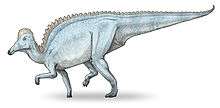Amurosaurus
| Amurosaurus | |
|---|---|
 | |
| Replica skeleton, Brussels | |
| Scientific classification | |
| Kingdom: | Animalia |
| Phylum: | Chordata |
| Clade: | Dinosauria |
| Order: | †Ornithischia |
| Suborder: | †Ornithopoda |
| Family: | †Hadrosauridae |
| Genus: | †Amurosaurus Bolotsky & Kurzanov, 1991 |
| Species: | †A. riabinini |
| Binomial name | |
| Amurosaurus riabinini Bolotsky & Kurzanov, 1991 | |
Amurosaurus (/əˌmʊəroʊˈsɔːrəs/; "Amur lizard") is a genus of lambeosaurine hadrosaurid dinosaur found in the latest Cretaceous period (66 million years ago)[1] of eastern Asia. Like most lambeosaurs, it would have been a primarily bipedal herbivore with a "duckbill" shaped snout and a hollow crest on top of its head, although such a crest has not been found. Fossil bones of adults are rare, but an adult would most likely have been at least 6 metres (20 ft) long. According to Gregory S. Paul, it was about 8 metres (26 ft) long and weighed about 3,000 kilograms (6,600 lb).[2]
Discovery


Russian paleontologists Yuri Bolotsky and Sergei Kurzanov first described and named this dinosaur in 1991. The generic name is derived from the Amur River and the Greek word sauros ("lizard"). The Amur (called Heilongjiang or "Black Dragon River" in Chinese) forms the border of Russia and China, and is near where this dinosaur's remains were found. There is one known species (A. riabinini), named in honor of the late Russian paleontologist Anatoly Riabinin, who conducted the first Russian expeditions to recover dinosaur remains in the Amur region in 1916 and 1917.[3][4]
All fossils of Amurosaurus have been recovered from a single bonebed locality, discovered in 1984 within the city limits of Blagoveschensk in the Amur Oblast of far eastern Russia. This bonebed is found in the Udurchukan Formation, the oldest geologic formation in the Tsagayan Group of far eastern Russia and northeastern China. This formation is thought to belong to the Maastrichtian stage of the Late Cretaceous Period, and was deposited about 68 million years ago, or just prior to the Lancian faunal stage of North America. The sediments were laid down in the floodplain of a river, which transported the fossils, but only a short distance, judging by the randomly assorted, disarticulated, but well-preserved bones within the bonebed, including fragile skull elements. Only a small section of the bonebed has been uncovered, but 90% of the remains found so far belong to lambeosaurines like Amurosaurus, mostly juveniles, with the rest belonging to other taxa, such as the hadrosaurine Kerberosaurus. Theropod teeth are also abundant, and there are many toothmarks on the bones, made by predators or scavengers.
The holotype, or original specimen, consists of only a maxilla (upper jaw bone), and a dentary (lower jaw bone), both from the left side of the same individual. However, most of the other bones of the skull and skeleton have also been preserved in the bonebed, albeit of many different individuals. This other material was described more recently, making Amurosaurus the most abundant and completely known Russian dinosaur.[4]
Description

Amurosaurus is characterized by many autapomorphies, or unique features, of the skull, as well as the sigmoidal shape of the ulna (a lower arm bone) when viewed from the front or side. Most other known lambeosaurines have hollow crests on the top of their skulls, and although the bones that would make up such a crest are unknown in this dinosaur, the bones of the roof of the skull are modified to support one, so it can be assumed that Amurosaurus was crested as well.
Classification

As most of its features were described recently, as of early 2006, Amurosaurus has only been subjected to one cladistic analysis, which placed it as a basal member of the lambeosaurine subfamily of hadrosaurs, but more derived than either Tsintaosaurus or Jaxartosaurus.
All known basal lambeosaurines come from Asia, which has led to the hypothesis that lambeosaurines originated there and then later dispersed across the Bering Strait to North America. Two derived groups, the parasaurolophins (Parasaurolophus, Charonosaurus) and lambeosaurins (Corythosaurus, Nipponosaurus, Lambeosaurus, etc.) evolved later. As members of both groups are found in North America and Asia (And one from Europe, which one is not solidly known.), there must have been further dispersal after their evolution, although in which direction that dispersal occurred is still unclear.[4][5]
The position of Amurosaurus in the evolutionary tree according to a 2013 study by Prieto-Márquez e.a. is indicated by this cladogram:[6]
| Lambeosaurinae |
| ||||||||||||||||||||||||||||||||||||||||||||||||||||||||||||||||||||||||||||||||||||||||||||||||||||||||||||||||||||||||
See also
References
- ↑ Godefroit, P., Lauters, P., Van Itterbeeck, J., Bolotsky, Y. and Bolotsky, I.Y. (2011). "Recent advances on study of hadrosaurid dinosaurs in Heilongjiang (Amur) River area between China and Russia." Global Geology, 2011(3).
- ↑ Paul, G.S., 2010, The Princeton Field Guide to Dinosaurs, Princeton University Press p. 308
- ↑ Bolotsky, Y.L. & Kurzanov, S.K. 1991. [The hadrosaurs of the Amur Region.] In: [Geology of the Pacific Ocean Border]. Blagoveschensk: Amur KNII. 94-103. [In Russian]
- 1 2 3 Godefroit, P., Bolotsky, Y.L., & Van Itterbeeck, J. 2004. The lambeosaurine dinosaur Amurosaurus riabinini, from the Maastrichtian of Far Eastern Russia. Acta Palaeontologica Polonica 49(4): 585–618. Available online as PDF Archived December 24, 2005, at the Wayback Machine.
- ↑ Suzuki, D., Weishampel, D.B., & Minoura, N. 2004. Nipponosaurus sachalinensis (Dinosauria, Ornithopoda): anatomy and systematic position within Hadrosauridae. Journal of Vertebrate Paleontology. 24(1): 145–164.
- ↑ A. Prieto-Marquez, F.M.D. Vecchia, R. Gaete and A. Galobart, 2013, "Diversity, relationships, and biogeography of the Lambeosaurine dinosaurs from the European archipelago, with description of the new aralosaurin Canardia garonnensis", PLoS One 8(7): e69835